Non-Targeted Screening and Identification of the Transformation Pathway of Carbamazepine in the Saemangeum Watershed, Republic of Korea
Abstract
1. Introduction
2. Results and Discussion
2.1. Carbamazepine Concentration in the Mangyeong and Dongjin Rivers
2.2. Analyzing TPs of Carbamazepine Using Non-Targeted Analysis
2.3. Spatial and Seasonal Variation in CBZ and Its Transformation Products in Surface Waters of the Mangyeong and Dongjin Rivers
2.3.1. Spatial Variation
2.3.2. Seasonal Variation
2.4. Additional Identification of CBZ TPs Based on Generating Molecular Networks
2.5. Proposed Pathway of CBZ Through Non-Targeted Analysis and Molecular Network Analysis
3. Materials and Methods
3.1. Chemical Standards and Reagents
3.2. Sampling Sites and Sample Collection
3.3. Liquid Chromatography (LC)–Orbitrap/High-Resolution Mass Spectrometry Analysis
3.4. Quality Assurance and Control
3.5. Data Processing for Non-Targeted Compound Identification
4. Conclusions
Supplementary Materials
Author Contributions
Funding
Institutional Review Board Statement
Informed Consent Statement
Data Availability Statement
Conflicts of Interest
References
- Tolouei, S.; Burnet, J.-B.; Autixier, L.; Taghipour, M.; Bonsteel, J.; Duy, S.V.; Sauvé, S.; Prévost, M.; Dorner, S. Temporal variability of parasites, bacterial indicators, and wastewater micropollutants in a water resource recovery facility under various weather conditions. Water Res. 2019, 148, 446–458. [Google Scholar] [CrossRef] [PubMed]
- Kryuchkova, M.; Batasheva, S.; Akhatova, F.; Babaev, V.; Buzyurova, D.; Vikulina, A.; Volodkin, D.; Fakhrullin, R.; Rozhina, E. Pharmaceuticals removal by adsorption with montmorillonite nanoclay. Int. J. Mol. Sci. 2021, 22, 9670. [Google Scholar] [CrossRef] [PubMed]
- Colopi, A.; Guida, E.; Cacciotti, S.; Fuda, S.; Lampitto, M.; Onorato, A.; Zucchi, A.; Balistreri, C.R.; Grimaldi, P.; Barchi, M. Dietary exposure to pesticide and veterinary drug residues and their effects on human fertility and embryo development: A global overview. Int. J. Mol. Sci. 2024, 25, 9116. [Google Scholar] [CrossRef]
- Morin-Crini, N.; Lichtfouse, E.; Liu, G.; Balaram, V.; Lado Ribeiro, A.R.; Lu, Z.; Stock, F.; Carmona, E.; Ribau Teixeira, M.; Picos-Corrales, L.A.; et al. Worldwide cases of water pollution by emerging contaminants: A review. Environ. Chem. Lett. 2022, 20, 2311–2338. [Google Scholar] [CrossRef]
- Aaahab, A. Difficulties in treatment and management of epilepsy and challenges in new drug development. Pharmaceuticals 2010, 3, 2090–2110. [Google Scholar] [CrossRef]
- Brezina, E.; Prasse, C.; Meyer, J.; Mückter, H.; Ternes, T.A. Investigation and risk evaluation of the occurrence of carbamazepine, oxcarbazepine, their human metabolites and transformation products in the urban water cycle. Sci. Total Environ. 2017, 225, 261–269. [Google Scholar] [CrossRef] [PubMed]
- Lertratanangkoon, K.; Horning, M.G. Metabolism of carbamazepine. Drug Metab. Dispos. 1982, 10, 1. [Google Scholar]
- Breton, H.; Cociglio, M.; Bressolle, F.; Peyriere, H.; Blayac, J.P.; Hillaire-Buys, D. Liquid chromatography-electrospray mass spectrometry determination of carbamazepine, oxcarbazepine and eight of their metabolites in human plasma. J. Chromatogr. B 2005, 828, 80–90. [Google Scholar] [CrossRef]
- Sinclair, C.J.; Boxall, A.B.A. Assessing the ecotoxicity of pesticide transformation products. Environ. Sci. Technol. 2003, 37, 4617–4625. [Google Scholar] [CrossRef]
- Jeon, J.; Kurth, D.; Hollender, J. Biotransformation pathways of biocides and pharmaceuticals in freshwater crustaceans based on structure elucidation of metabolites using high-resolution mass spectrometry. Chem. Res. Toxicol. 2013, 26, 313–324. [Google Scholar] [CrossRef]
- Kaiser, E.; Prasse, C.; Bröder, K.; Ternes, T.A. Transformation of oxcarbazepine and human metabolites of carbamazepine and oxcarbazepine in wastewater treatment and sand filters. Environ. Sci. Technol. 2013, 48, 10208–10216. [Google Scholar] [CrossRef] [PubMed]
- Barrios-Estrada, C.; Rostro-Alanis, M.J.; Muñoz-Gutiérrez, B.D.; Iqbal, H.M.N.; Kannan, S.; Parra-Saldívar, R. Emergent contaminants: Endocrine disruptors and their laccase-assisted degradation—A review. Sci. Total Environ. 2018, 612, 1516–1531. [Google Scholar] [CrossRef] [PubMed]
- Im, J.K.; Hwang, M.Y.; Lee, E.H.; Noh, H.R.; Yu, S.J. Pharmaceutical compounds in tributaries of the Han River watershed, South Korea. Environ. Res. 2020, 188, 1097585. [Google Scholar] [CrossRef] [PubMed]
- Miao, X.-S.; Yang, J.-J.; Metcalfe, C.D. Carbamazepine and its metabolites in wastewater and in biosolids in a municipal wastewater treatment plant. Environ. Sci. Technol. 2005, 39, 7469–7475. [Google Scholar] [CrossRef]
- Ben, W.; Zhu, B.; Yuan, X.; Yang, M.; Qiang, Z. Occurrence, removal and risk of organic micropollutants in wastewater treatment plants across China: Comparison of wastewater treatment processes. Water Res. 2018, 130, 38–46. [Google Scholar] [CrossRef]
- Liu, Q.; Wang, L.; Xu, X.; Yan, S.; Zha, J.; Wang, D.; Zhu, D. Antiepileptic drugs in aquatic environments: Occurrence, toxicity, transformation mechanisms and fate. Crit. Rev. Environ. Sci. Technol. 2023, 211, 2030–2054. [Google Scholar] [CrossRef]
- Brooks, B.W.; Berninger, J.P.; Ramirez, A.J.; Huggett, D.B. Perspectives on human pharmaceuticals in the environment. In Human Pharmaceuticals in the Environment; Springer: New York, NY, USA, 2012; Volume 1, pp. 1–16. [Google Scholar]
- Zind, H.; Mondamert, L.; Blancart, Q.R.; Cléon, A.; Karpel-Vel Leitner, N.; Labanowski, J. Occurrence of carbamazepine, diclofenac, and their related metabolites and transformation products in a French aquatic environment and preliminary risk assessment. Water Res. 2021, 196, 117052. [Google Scholar] [CrossRef] [PubMed]
- Ebrahimzadeh, S.; Castiglioni, S.; Riva, F.; Zuccato, E.; Azzellino, A. Carbamazepine levels related to the demographic indicators in groundwater of densely populated areas. Water 2021, 13, 2539. [Google Scholar] [CrossRef]
- Kråkström, M.; Saeid, S.; Tolvanen, P.; Salmi, T.; Eklund, P.; Kronberg, L. Catalytic ozonation of the antibiotic sulfadiazine: Reaction kinetics and transformation mechanisms. Chemosphere 2020, 247, 125853. [Google Scholar] [CrossRef]
- Pierpaoli, M.; Dettlaff, A.; Szopińska, M.; Karpienko, K.; Wróbel, M.; Łuczkiewicz, A.; Fudala-Książek, S.; Bogdanowicz, R. Simultaneous opto-electrochemical monitoring of carbamazepine and its electro-oxidation by-products in wastewater. J. Hazard. Mater. 2021, 419, 126509. [Google Scholar] [CrossRef]
- Gasperi, J.; Le Roux, J.; Deshayes, S.; Ayrault, S.; Bordier, L.; Boudahmane, L.; Budzinski, H.; Caupos, E.; Caubriere, N.; Flanagan, K.; et al. Micropollutants in urban runoff from traffic areas: Target and non-target screening on four contrasted sites. Water 2022, 14, 394. [Google Scholar] [CrossRef]
- Yang, Y.; Yang, L.; Zheng, M.; Cao, D.; Liu, G. Data acquisition methods for non-targeted screening in environmental analysis. TrAC Trends Anal. Chem. 2023, 160, 116966. [Google Scholar] [CrossRef]
- Hird, S.J.; Lau, B.P.-Y.; Schuhmacher, R.; Krska, R. Liquid chromatography-mass spectrometry for the determination of chemical contaminants in food. TrAC Trends Anal. Chem. 2014, 59, 59–72. [Google Scholar] [CrossRef]
- Samanipour, S.; Kaserzon, S.; Vijayasarathy, S.; Jiang, H.; Choi, P.; Reid, M.J.; Mueller, J.F.; Thomas, K.V. Machine learning combined with non-targeted LC-HRMS analysis for a risk warning system of chemical hazards in drinking water: A proof concept. Talanta 2019, 195, 426–432. [Google Scholar] [CrossRef]
- Purschke, K.; Vasough, M.; Leonhardt, J.; Weber, M.; Schmidti, T. Evaluation of nontarget long-term LC-HRMS time series data using multivariate statistical approaches. Anal. Chem. 2020, 92, 12273–12281. [Google Scholar] [CrossRef] [PubMed]
- Nothias, L.-F.; Petras, D.; Schmid, R.; Dührkop, K.; Rainer, J.; Sarvepalli, A.; Protsyuk, I.; Ernst, M.; Tsugawa, H.; Fleischauer, M.; et al. Feature-based molecular networking in the GNPS analysis environment. Nat. Methods 2020, 17, 905–908. [Google Scholar] [CrossRef]
- Qin, G.-F.; Zhang, X.; Zhu, F.; Huo, Z.-Q.; Yao, Q.-Q.; Feng, Q.; Liu, Z.; Zhang, G.-M.; Yao, J.-C.; Liang, H.-B. MS/MS-Based Molecular Networking: An Efficient Approach for Natural Products Dereplication. Molecules 2023, 28, 157. [Google Scholar]
- Zhang, M.; Otsuki, K.; Li, W. Molecular networking as a natural products discovery strategy. Acta Mater. Med. 2023, 2, 126–141. [Google Scholar] [CrossRef]
- He, F.; Zeng, F.; Situ, X.; He, R.; Zheng, W.; Chen, Y.; Ou, D.; Chen, Y. Detection and identification of imperatorin metabolites in rat, dog, monkey, and human liver microsomes by ultra-high-performance liquid chromatography combined with high-resolution mass spectrometry and Compound Discoverer software. Biomed. Chromatogr. 2023, 37, 5702. [Google Scholar] [CrossRef]
- Pelletier, R.; Bourdais, A.; Fabresse, N.; Ferron, P.-J.; Morel, I.; Gicquel, T.; Le Daré, B. In silico and in vitro metabolism studies of the new synthetic opiate AP-237 (bucinnazine) using bioinformatics tools. Arch. Toxicol. 2024, 98, 165–179. [Google Scholar] [CrossRef]
- Park, N.; Choi, Y.; Kim, D.; Kim, K.; Jeo, J. Prioritization of highly exposable pharmaceuticals via a suspect/non-target screening approach: A case study for Yeongsan River, Korea. Sci. Total Environ. 2018, 639, 570–579. [Google Scholar] [CrossRef] [PubMed]
- Park, N.; Jeon, J. Emerging pharmaceuticals and industrial chemicals in Nakdong River, Korea: Identification, quantitative monitoring, and prioritization. Chemosphere 2021, 263, 128014. [Google Scholar] [CrossRef]
- Lee, H.; Chae, M.; Lee, S. Environmental monitoring and risk assessment of pharmaceutical residues discharged from large livestock complex in the Geum River Basin, South Korea. Water 2023, 15, 3913. [Google Scholar] [CrossRef]
- József, T.; Kiss, S.R.; Muzslay, F.; Máté, O.; Stromájer, G.P.; Stromájer, G.P.; Stromájer-Rácz, T. Detection and quantification of pharmaceutical residues in the Pest County section of the River Danube. Water 2023, 15, 1755. [Google Scholar] [CrossRef]
- Jurado, A.; López-Serna, R.; Vázquez-Suné, E.; Carrera, J.; Pujades, E.; Petrovic, M.; Barceló, D. Occurrence of carbamazepine and five metabolites in an urban aquifer. Chemosphere 2014, 115, 47–53. [Google Scholar] [CrossRef]
- Azuma, T.; Ishiuchi, H.; Inoyama, T.; Teranishi, Y.; Sato, T.; Mino, Y. Occurrence and fate of selected anticancer, antimicrobial, and psychotropic pharmaceuticals in an urban river in a subcatchment of the Yodo River basin, Japan. Environ. Sci. Pollut. Res. 2015, 22, 18676–18686. [Google Scholar] [CrossRef] [PubMed]
- Vaudreuil, M.-A.; Munoz, G.; Duy, S.V.; Sauvè, S. Tracking down pharmaceutical pollution in surface waters of the St. Lawrence River and its major tributaries. Sci. Total Environ. 2024, 912, 168680. [Google Scholar] [CrossRef]
- Schymanski, E.L.; Jeon, J.; Gulde, R.; Fenner, K.; Ruff, M.; Singer, H.P.; Hollender, J. Identifying small molecules via high-resolution mass spectrometry: Communicating confidence. Environ. Sci. Technol. 2014, 48, 2097–2098. [Google Scholar] [CrossRef]
- Bleeker, E.A.J.; Van der Geest, H.G.; Klamer, H.J.C.; De Voogt, P.; Wind, E.; Kraak, M.H.S. Toxic and genotoxic effects of azaarenes: Isomers and metabolites. Polycycl. Aromat. Compd. 1999, 13, 191–203. [Google Scholar] [CrossRef]
- Leclercq, M.; Mathieu, O.; Gomez, E.; Casellas, C.; Fenet, H.; Hillaire-Buys, D. Presence and fate of carbamazepine, oxcarbazepine, and seven of their metabolites at wastewater treatment plants. Arch. Environ. Contam. Toxicol. 2009, 56, 408–415. [Google Scholar] [CrossRef]
- Furst, S.M.; Uetrecht, J.P. Carbamazepine metabolism to a reactive intermediate by the myeloperoxidase system of activated neutrophils. Biochem. Pharmacol. 1993, 45, 1267–1275. [Google Scholar] [CrossRef] [PubMed]
- Mathieu, O.; Dereure, O.; Hillaire-Buys, D. Presence and ex vivo formation of acridone in blood of patients routinely treated with carbamazepine: Exploration of the 9-acridinecarboxaldehyde pathway. Xenobiotica 2011, 41, 91–100. [Google Scholar] [CrossRef] [PubMed]
- Gonzalez-Gil, L.; Krah, D.; Ghattas, A.K.; Carballa, M.; Wick, A.; Helmholz, L.; Lema, J.M.; Ternes, T.A. Biotransformation of organic micropollutants by anaerobic sludge enzymes. Water Res. 2019, 152, 202–214. [Google Scholar] [CrossRef]
- Watkinson, A.J.; Murby, E.J.; Costanzo, S.D. Removal of antibiotics in conventional and advanced wastewater treatment: Implications for environmental discharge and wastewater recycling. Water Res. 2007, 41, 4164–4176. [Google Scholar] [CrossRef]
- Aga, D.S. Fate of pharmaceuticals in the environment and in water treatment systems. J. Environ. Monit. 2008, 10, 353–361. [Google Scholar]
- Nakada, N.; Kiri, K.; Shinohara, H.; Harada, A.; Kuroda, K.; Takizawa, S.; Takada, H. Evaluation of pharmaceuticals and personal care products as water-soluble molecular markers of sewage. Environ. Sci. Technol. 2008, 42, 6347–6353. [Google Scholar] [CrossRef]
- Kalis, M.M.; Huff, N.A. Oxcarbazepine, an antiepileptic agent. Clin. Ther. 2001, 23, 680–700. [Google Scholar] [CrossRef]
- Korea Meteorological Administration. Climate Statistics Analysis; Korea Meteorological Administration: Seoul, Republic of Korea, 2021. [Google Scholar]
- Xu, L.; Xiong, H.; Li, Z.; Liao, H.; Yin, H.; Wu, J. Influences of rainfall variables and antecedent discharge on urban effluent concentrations and loads in wet weather. Water Sci. Technol. 2017, 75, 1584–1598. [Google Scholar] [CrossRef] [PubMed]
- Lee, Y.-Y.; Fan, C.; Haque, F. Hybrid combination of advanced oxidation and biological processes for the micropollutant removal of carbamazepine. Clean Water 2022, 5, 60. [Google Scholar] [CrossRef]
- Monsalvo, V.M.; Lopez, J.; Munoz, M.; de Pedro, Z.M.; Casas, J.A.; Mohedano, A.F.; Rodriguez, J.J. Application of Fenton-like oxidation as pre-treatment for carbamazepine biodegradation. Chem. Eng. J. 2015, 264, 856–862. [Google Scholar] [CrossRef]
- Statistics Korea. Resident Registration Population Statistics; E-Nara Indicator; Statistics Korea: Daejeon, Republic of Korea, 2021. [Google Scholar]
- Ministry of Environment. Status of Public Sewage Treatment Facilities; Ministry of Environment: Sejong, Republic of Korea, 2021. [Google Scholar]
- Gonzalez-Gaya, B.; Lopez-Herguedas, N.; Santamaria, A.; Mijangos, F.; Etxebarria, N.; Olivares, M.; Prieto, A.; Zuloaga, O. Suspect screening workflow comparison for the analysis of organic xenobiotics in environmental water samples. Chemosphere 2021, 274, 129964. [Google Scholar] [CrossRef] [PubMed]
- Lopez-Herguedas, N.; Irazola, M.; Alvarez-Mora, I.; Orive, G.; Lertxundi, U.; Olivares, M.; Zuloaga, O.; Prieto, A. Comprehensive micropollutant characterization of wastewater during COVID-19 crisis in 2020: Suspect screening and environmental risk prioritization strategy. Sci. Total Environ. 2023, 873, 162281. [Google Scholar] [CrossRef] [PubMed]
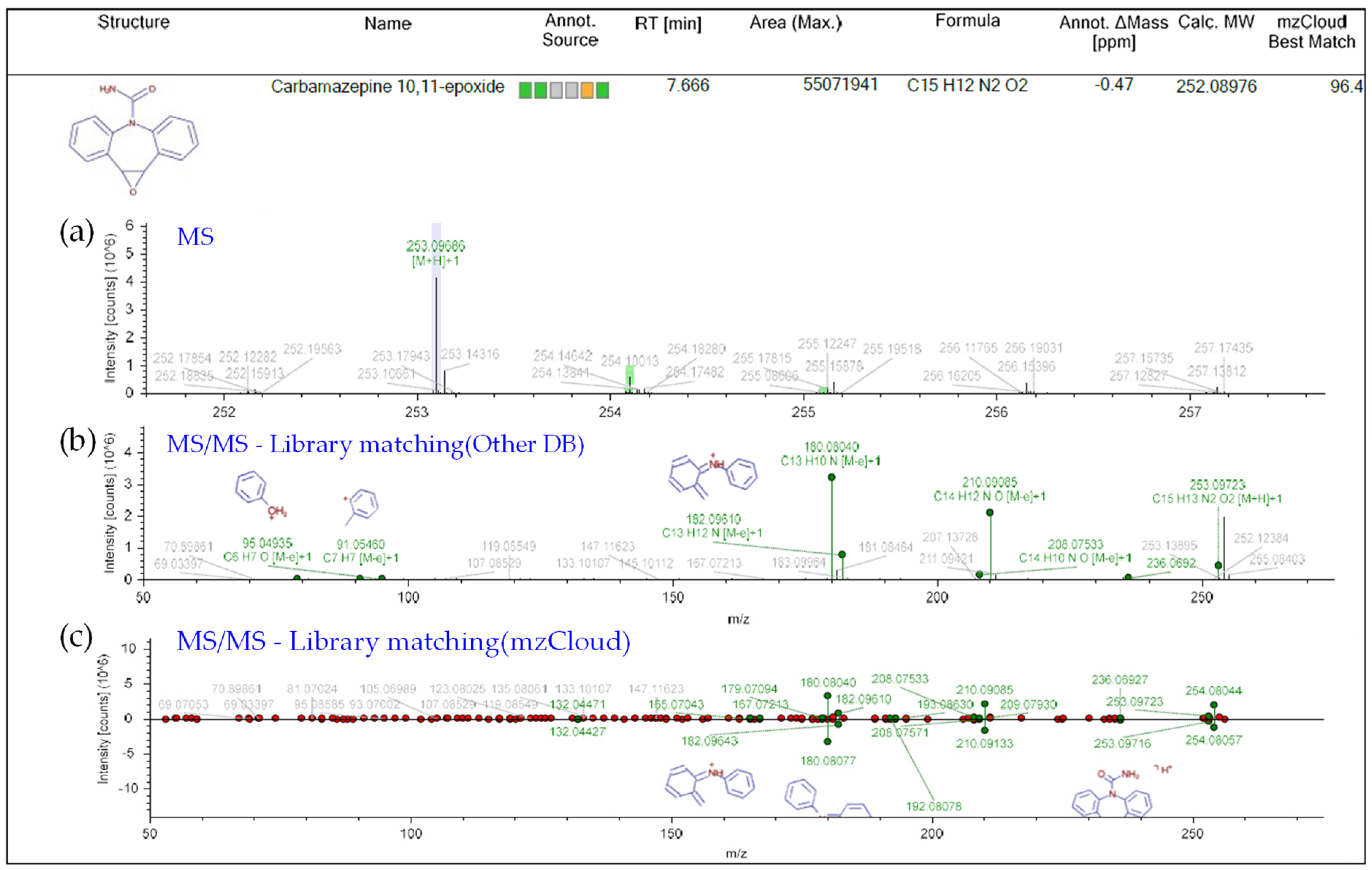
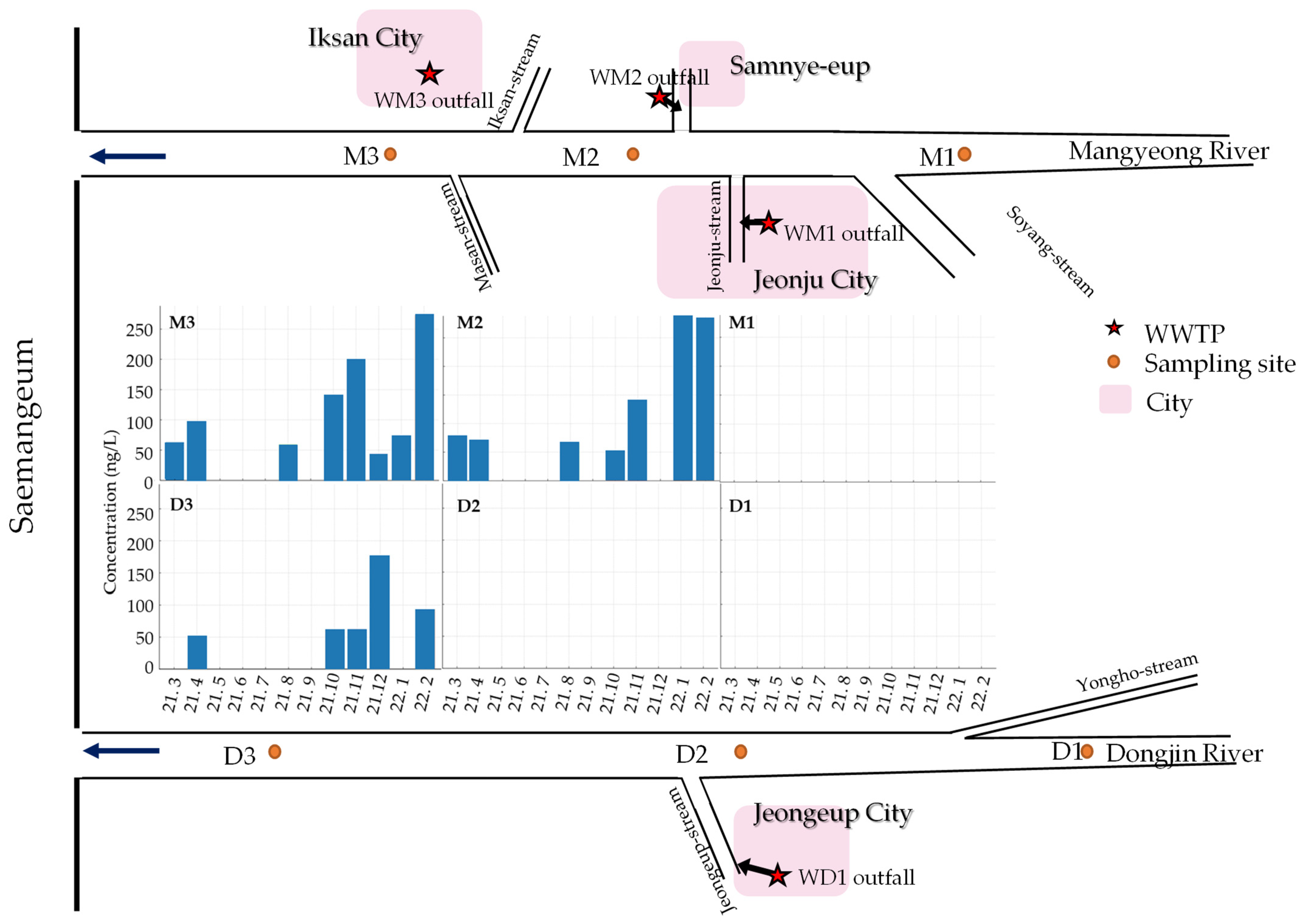

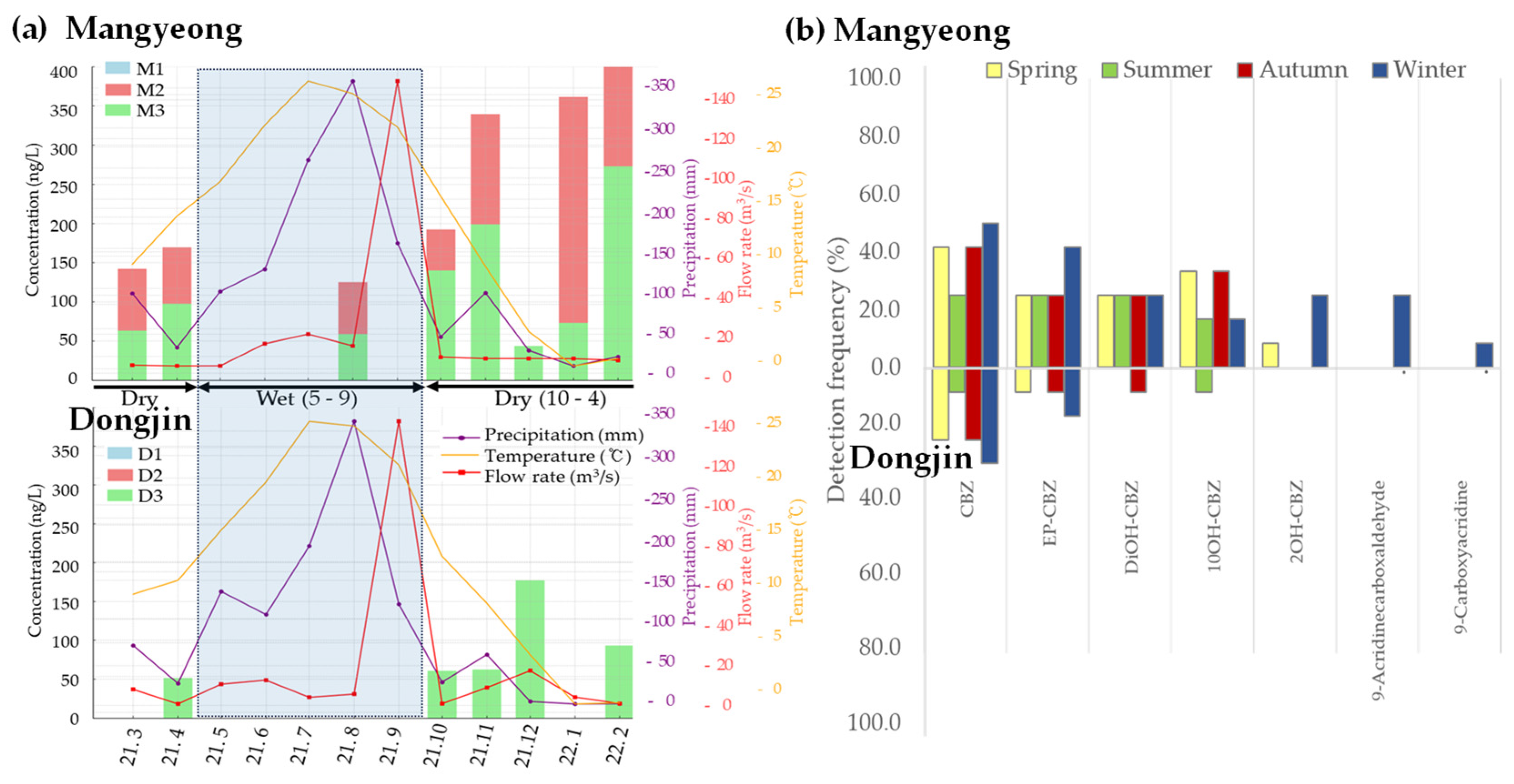
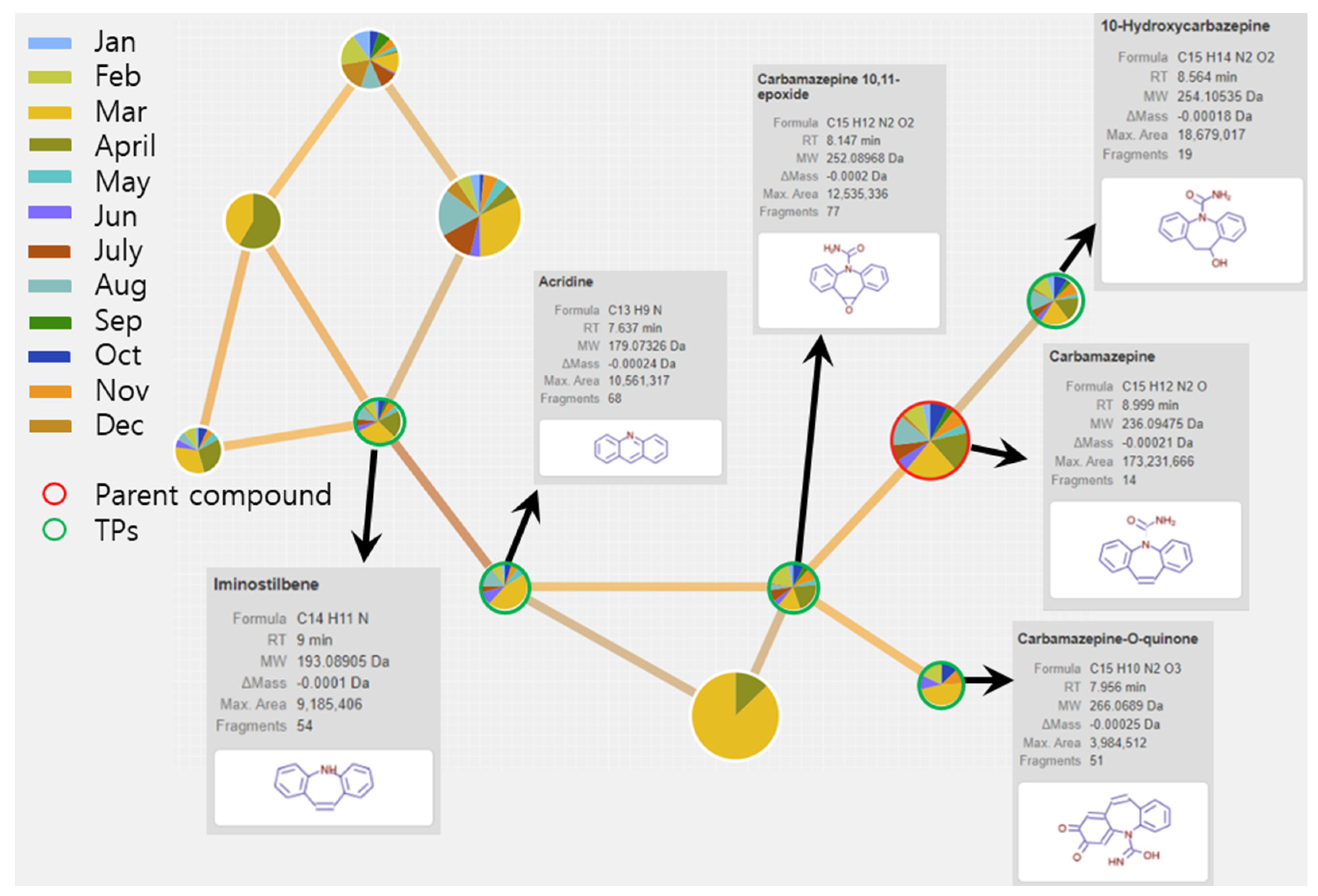

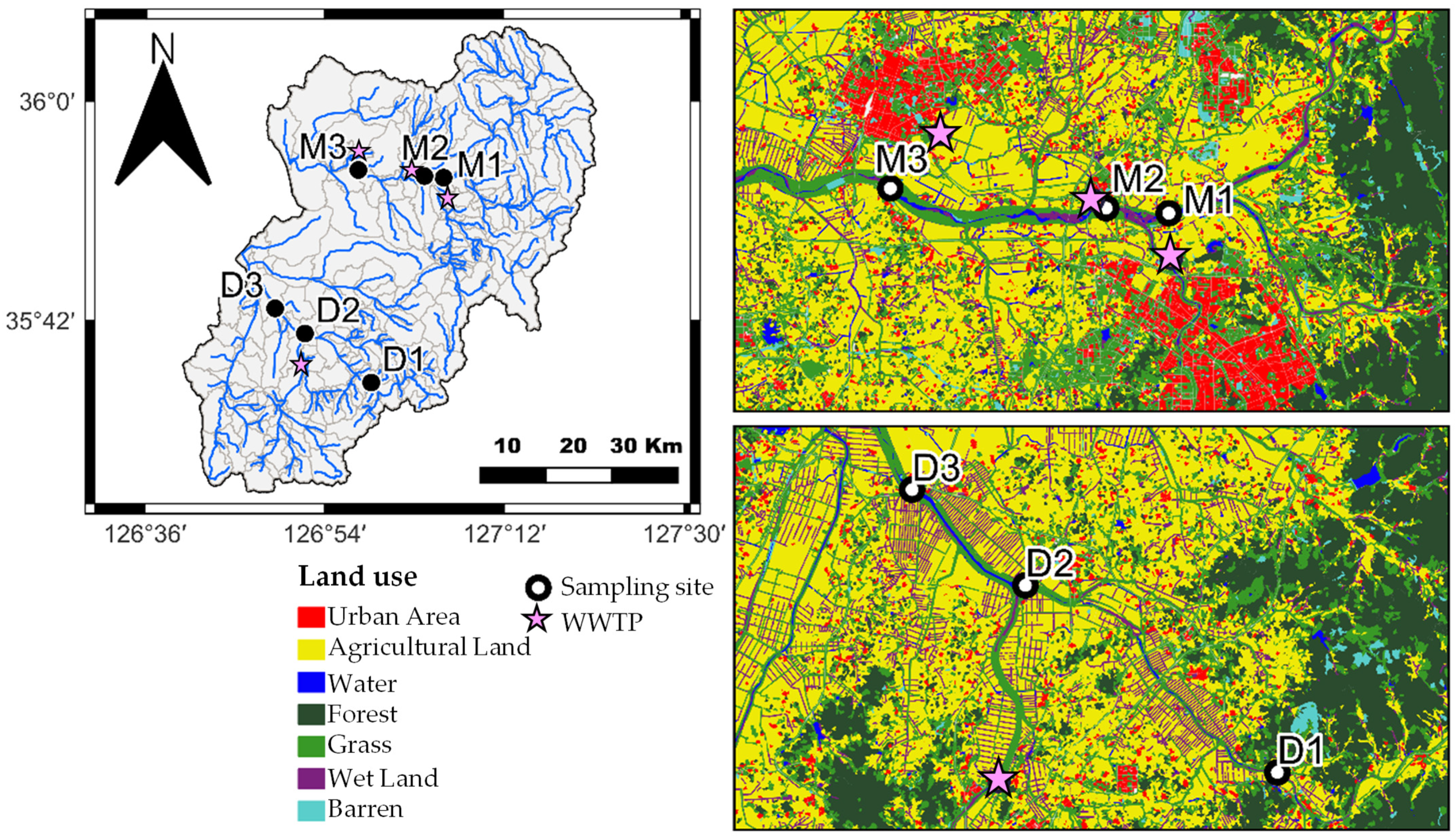
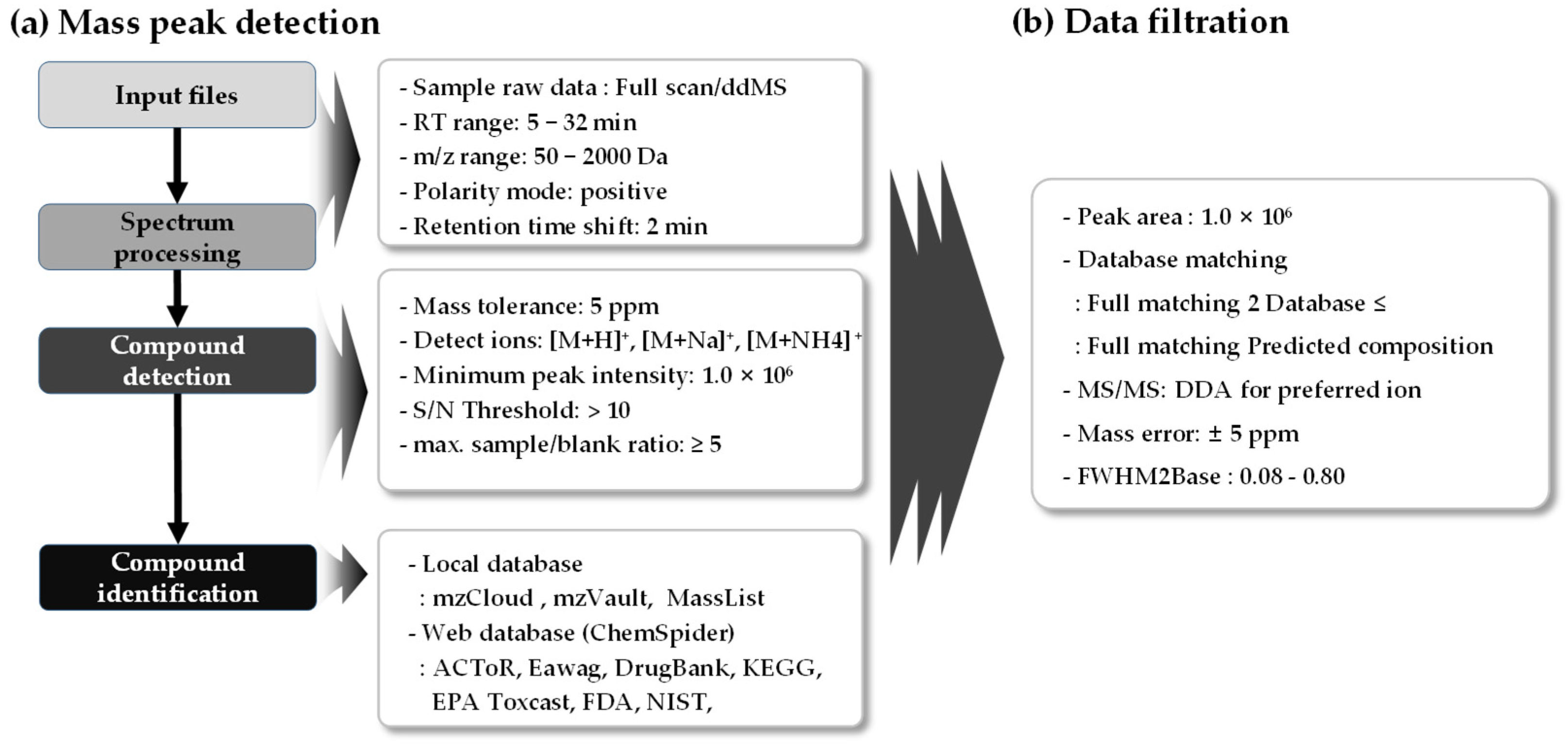
| Site | Concentration (ng/L) | Detection Frequency DF (%) | |||
|---|---|---|---|---|---|
| Range | Mean | Median | |||
| Mangyeong River | M1 (n = 12) | <LOQ | <LOQ | <LOQ | |
| M2 (n = 12) | 52.2–288.2 | 140.5 | 79.1 | 58.3 | |
| M3 (n = 12) | 43.8–273.1 | 118.6 | 85.6 | 66.7 | |
| Total (n = 36) | 43.8–288.2 | 128.8 | 79.1 | 41.7 | |
| Dongjin River | D1 (n = 12) | n/d | n/d | n/d | - |
| D2 (n = 12) | <LOQ | <LOQ | <LOQ | - | |
| D3 (n = 12) | 51.7–177.7 | 89.0 | 62.4 | 50 | |
| Total (n = 36) | 51.7–177.7 | 89.0 | 62.4 | 13.9 | |
| No. | Name | RT (min) | Formula | m/z | Mass Accuracy (ppm) | Match Score | Confidence Level | Structure |
|---|---|---|---|---|---|---|---|---|
| 1 | EP-CBZ | 7.666 | C15H12N2O2 | 253.097 | −0.47 | 96.4 | 2a †,‡ |  |
| 2 | DiOH-CBZ | 7.670 | C15H14N2O3 | 271.108 | −0.9 | 73.2 | 2a †,‡ |  |
| 3 | 2OH-CBZ | 7.872 | C15H12N2O2 | 253.097 | −0.81 | - | 2b †,‡ |  |
| 4 | 10OH-CBZ | 7.870 | C15H14N2O2 | 255.113 | −0.96 | 96.7 | 2a †,‡ |  |
| 5 | 9-Acridinecarboxaldehyde (9-Formylacridne) | 8.576 | C14H9NO | 208.076 | −0.81 | - | 2b † |  |
| 6 | 9-Carboxyacridine (9-Acridinecarboxylic acid) | 8.776 | C14H9NO2 | 224.070 | −2.97 | 84 | 2a † |  |
| Identification Confidence | Minimum Data Requirements | ||
|---|---|---|---|
| Level 1: | confirmed structure by reference standard | MS/MS2/RT/Reference Std. | |
| Level 2: | Level 2a: | probable structure by library spectrum match | MS/MS2/Library(in house DB) MS2 |
| Level 2b: | MS/MS2/Library(online DB) MS2 | ||
| Level 3: | tentative candidate by structure, substituent, class | MS/MS2/Exp. Data | |
| Level 4: | unequivocal molecular formula | MS/Isotope/adduct | |
| Level 5: | exact mass of interest | MS | |
Disclaimer/Publisher’s Note: The statements, opinions and data contained in all publications are solely those of the individual author(s) and contributor(s) and not of MDPI and/or the editor(s). MDPI and/or the editor(s) disclaim responsibility for any injury to people or property resulting from any ideas, methods, instructions or products referred to in the content. |
© 2024 by the authors. Licensee MDPI, Basel, Switzerland. This article is an open access article distributed under the terms and conditions of the Creative Commons Attribution (CC BY) license (https://creativecommons.org/licenses/by/4.0/).
Share and Cite
Jeon, D.R.; Kim, Y.-E.; Im, J.K.; Huh, Y.; Kim, H.S. Non-Targeted Screening and Identification of the Transformation Pathway of Carbamazepine in the Saemangeum Watershed, Republic of Korea. Int. J. Mol. Sci. 2024, 25, 11947. https://doi.org/10.3390/ijms252211947
Jeon DR, Kim Y-E, Im JK, Huh Y, Kim HS. Non-Targeted Screening and Identification of the Transformation Pathway of Carbamazepine in the Saemangeum Watershed, Republic of Korea. International Journal of Molecular Sciences. 2024; 25(22):11947. https://doi.org/10.3390/ijms252211947
Chicago/Turabian StyleJeon, Da Rae, Young-Eun Kim, Jong Kwon Im, Yujeong Huh, and Hyoung Seop Kim. 2024. "Non-Targeted Screening and Identification of the Transformation Pathway of Carbamazepine in the Saemangeum Watershed, Republic of Korea" International Journal of Molecular Sciences 25, no. 22: 11947. https://doi.org/10.3390/ijms252211947
APA StyleJeon, D. R., Kim, Y.-E., Im, J. K., Huh, Y., & Kim, H. S. (2024). Non-Targeted Screening and Identification of the Transformation Pathway of Carbamazepine in the Saemangeum Watershed, Republic of Korea. International Journal of Molecular Sciences, 25(22), 11947. https://doi.org/10.3390/ijms252211947







